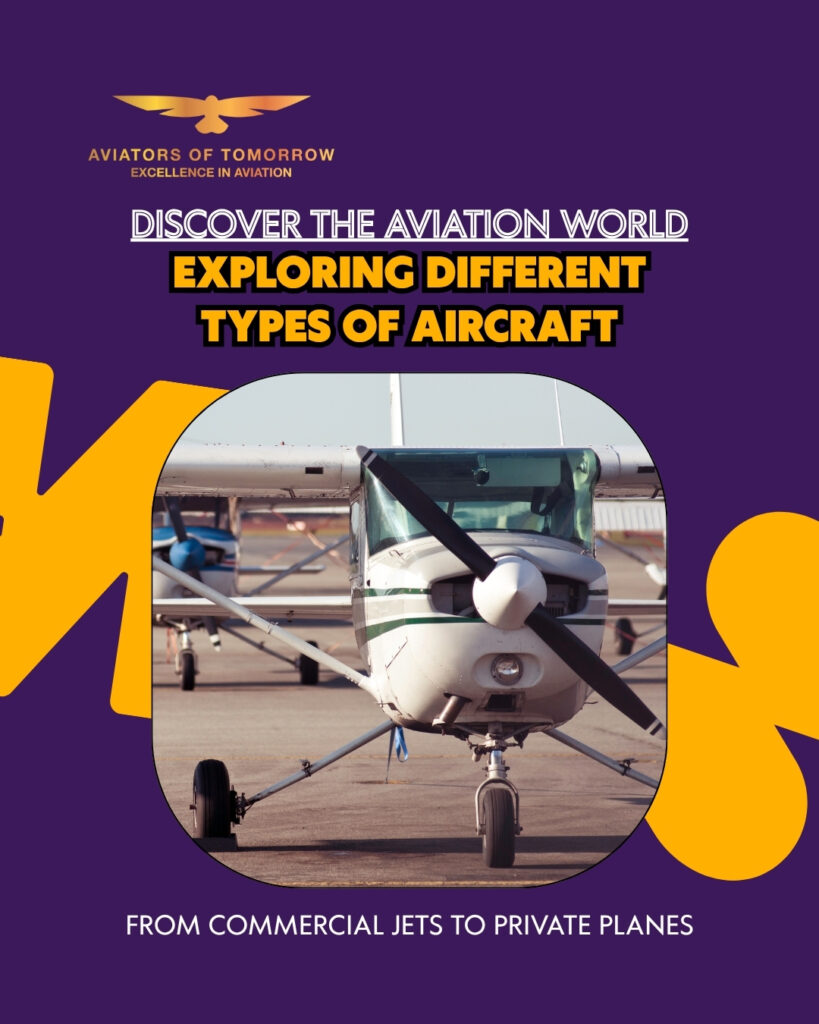Welcome to the complete guide on the different types of aircraft used in flight training. For anyone aspiring to become a pilot, understanding the range of aircraft used during training is essential. Flight schools don’t rely on a single airplane for all instruction. Instead, students gain experience across different types of aircraft, each offering unique lessons that build the foundation for a pilot’s skills, confidence, and career.
In this article, we’ll explore the most common kinds of aircraft, as well as some specialized options that give student pilots a competitive edge. Whether you’re curious about beginner trainers or advanced jets, this guide covers it all.
Table of Contents

Takeoff: Why Different Types of Aircraft Matter
Flight training is not a one-size-fits-all experience. The different kinds of aircraft that students use during training are carefully chosen to match skill progression. Starting with simple, forgiving planes and gradually introducing complex, high-performance aircraft ensures a smooth learning curve. Exposure to multiple different t of aircraft helps pilots:
- Develop well-rounded flying skills
- Build confidence in handling diverse scenarios
- Gain experience with both piston and turbine-powered aircraft
- Prepare for career-specific challenges
By training on different types of aircraft, students develop versatile and adaptable qualities every professional pilot needs. Moreover, before pilot training, always check that your flight school is DGCA (Directorate General of Civil Aviation) approved.
Single-Engine Aircraft: The Basics Start Here
Single-engine airplanes like the Cessna 172 and Piper PA-28 are the most common types of aircraft in primary flight training. They are ideal for beginners because of their:
- Simple controls
- Reliable engines
- Stable flight characteristics
These aircraft teach students essential skills such as takeoff, landing, navigation, and emergency procedures. Single-engine planes are forgiving enough to allow for mistakes, yet versatile enough to practice cross-country flights and instrument procedures. For most pilots, their first flight experience is with one of these different types of aircraft, making them a cornerstone of aviation education.
Multi-Engine Aircraft: Mastering Complexity
Once students have mastered the basics, they transition to multi-engine aircraft, such as the Piper Seminole or Tecnam P2006T. These different types of aircraft introduce more complex systems and higher speeds, helping pilots learn to:
- Manage two engines efficiently
- Handle asymmetric thrust during an engine failure
- Perform advanced navigation and systems management
Training on multi-engine planes is mandatory for pilots pursuing a commercial license. Exposure to these different types of aircraft ensures that students are ready for larger aircraft and real-world commercial flying scenarios.
Helicopters: Vertical Mastery
Not all pilots stick to fixed-wing aircraft. Helicopters, such as the Robinson R22, are unique, different types of aircraft that require a completely different skill set.
Students learn vertical takeoffs and landings, hovering techniques, and autorotation procedures. Training in helicopters is invaluable for careers in:
- Emergency Medical Services (EMS)
- Search and rescue
- Offshore transportation
- Tourism
Mastering these different types of aircraft gives pilots specialized skills that are not applicable in traditional airplanes.
Tailwheel Aircraft: Stick-and-Rudder Mastery
Tailwheel aircraft, like the Piper Cub and American Champion Citabria, are classic different types of aircraft with a historical reputation for challenging ground handling.
Learning in tailwheel planes develops:
- Rudder coordination
- Precision during takeoff and landing
- Confidence in handling less-stable aircraft
Pilots trained in tailwheel different types of aircraft are better prepared for bush flying, aerobatics, and backcountry operations.
Seaplanes: Beyond the Runway
Seaplanes, such as the Cessna 206 on floats or the De Havilland Beaver, are specialized types of aircraft designed to operate on water.
Seaplane training teaches:
- Water takeoffs and landings
- Docking and taxiing on rivers or lakes
- Adapting to variable water and wind conditions
Although optional, this training adds versatility to a pilot’s skillset. In regions like Alaska, Canada, or the Maldives, familiarity with these different types of aircraft is particularly valuable.
Turboprop Trainers: The Bridge to Bigger Aircraft
Turboprop aircraft like the Pilatus PC-7 or Beechcraft King Air are advanced, different types of aircraft used for transitioning students from piston trainers to jets.
These aircraft offer:
- Pressurization systems
- Retractable landing gear
- Modern avionics
By training on turboprops, students learn to manage faster speeds and more complex systems, preparing them for regional airlines and advanced career stages.
Jet Trainers: The Skies at High Speed
For students aiming for airline or military careers, jet trainers are some of the most sophisticated types of aircraft available. Examples include the Cessna Citation Mustang and HAL Hawk Mk132.
Jet training helps pilots adapt to:
- High-performance aircraft systems
- Increased speed and altitude
- Decision-making in complex flight environments
Training on these different types of aircraft ensures pilots are ready for modern airliners or military aircraft.
Aerobatic Aircraft: Advanced Handling
Aerobatic planes, like the Extra 300, are specialized types of aircraft used to teach advanced maneuvers. Students learn:
- Spins and stalls
- Loops and rolls
- Upset recovery techniques
Aerobatic training enhances confidence, reflexes, and resilience — crucial for real-world emergencies.
Simulators: Digital Training, Real Skills
While not physical airplanes, simulators are an essential component of different types of aircraft training. They allow students to:
- Practice instrument procedures
- Manage emergencies safely
- Get hands-on experience with modern glass cockpits
Simulators reduce training costs and allow for repeated practice, complementing experience on real aircraft.
Gliders and Ultralights: Back to Basics
Gliders and ultralights are lightweight, different types of aircraft that teach:
- Pure stick-and-rudder control
- Energy management
- Basic flight handling
Though less common in formal training, these aircraft provide a fun and accessible way for students to reinforce fundamental skills.
You may also read our blog about “DGCA Ground Classes vs Flight Training“
Final Thoughts: Building Skills Across Different Types of Aircraft
The journey to becoming a skilled pilot is shaped by experience in a wide range of different types of aircraft. From single-engine trainers to advanced jets, seaplanes, helicopters, and simulators, each aircraft type contributes unique lessons and builds a pilot’s confidence.
Understanding the variety of different types of aircraft used during flight training helps aspiring aviators plan their training path and develop versatile skills. Whether taking off in a Cessna, mastering a Hawk jet, or hovering a Robinson R22, exposure to these aircraft ensures every pilot is prepared for the challenges of the sky.

